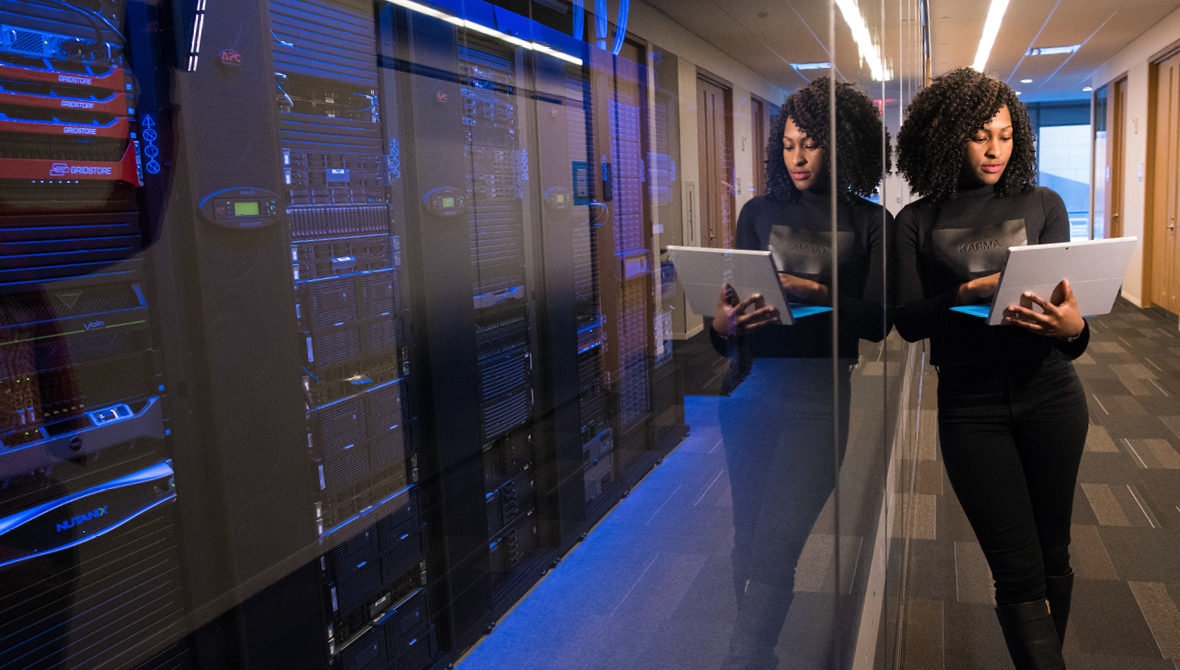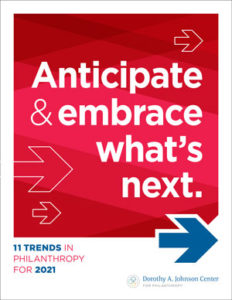Data Comes of Age in Philanthropy


 It is time to retire the adage that individuals and organizations are “swimming in data” or “lost in a sea of data.” Those sentiments may have been apt in 2010 when the internet was barely 20 years old as a public construct, and we created as much information every two days as existed from the dawn of time to 2003 (Siegler, 2010). Ten years on — especially as it relates to both people and philanthropic organizations — data is more like air than water. It surrounds us; in 2019, the top web properties in the world handled nearly 270 million interactions each minute (Desjardins). And it has become an afterthought; like air, data is noticed only when it is polluted or available in less-than-expected quantities.
It is time to retire the adage that individuals and organizations are “swimming in data” or “lost in a sea of data.” Those sentiments may have been apt in 2010 when the internet was barely 20 years old as a public construct, and we created as much information every two days as existed from the dawn of time to 2003 (Siegler, 2010). Ten years on — especially as it relates to both people and philanthropic organizations — data is more like air than water. It surrounds us; in 2019, the top web properties in the world handled nearly 270 million interactions each minute (Desjardins). And it has become an afterthought; like air, data is noticed only when it is polluted or available in less-than-expected quantities.
If my organization knows something that your organization does not know, that gives me a strategic advantage — which is the primary argument for keeping data tightly held. But in an era when data is more widely available than any time in history, the odds of truly keeping data private are low. In a world where data is widely available, the effectiveness of philanthropy hinges on how well and how quickly nonprofits, foundations, and donors can act upon data that everyone has (or shortly will have).
And therein lies the challenge. As data has become as common as air, we see confounding and competing factors that challenge philanthropy and the quest for the common good:
That more data is available about programs and services from government, business, and nonprofits alike is generally a good thing. But the opposite side is an erosion of privacy, with potential harmful effects if data is used to identify at-risk individuals (see 2019 Trend, “Powering Communities While Protecting Individuals”). This debate is not new — between 1890 and 1913, Louis Brandeis wrote essays that both extolled the virtue of privacy as well as the duty of publicity (and coined the memorable phrase, “Sunlight is said to be the best of disinfectants”).
What is new in 2020 versus the 1900s is that the quantity of data, ease of access, and speed of retrieval have been exponentially improved. Striking that balance between privacy and transparency is paramount for the philanthropic sector, which often works with the most at-risk populations and communities. Witness the 2020 debate, and subsequent release of the data about which entities received a Payroll Protection Program loan. “COVID-shaming” caused several eligible foundations and nonprofits to return funds in the face of substantial negative public opinion, which was exactly what some organizations feared prior to applying for the loans. Balancing individual privacy and community transparency will be a key factor in building, maintaining, and reinforcing community trust in the philanthropic sector.
Philanthropy and policy makers often assume — and rely upon — widespread access to the internet. Worldwide, the research firm Statista (2020) estimates that nearly 60% of the total global population has access to the internet, and more than four billion people have reliable access to the mobile internet. Facebook, Mailchimp, WordPress, and Constant Contact are a few of the free or low-cost tools that have revolutionized — and democratized — the ways that nonprofits can communicate and engage with clients, volunteers, supporters, and policymakers.
“How individual philanthropic organizations balance privacy and transparency, address equity of access, and act upon data to create and share actionable knowledge will be key to both fulfilling their missions as well as changing their communities for good.”
But averages mask variation. The COVID-19 pandemic is highlighting disparities in high-speed internet access in the United States — especially in communities and school districts with high rates of poverty. Philanthropy has stepped in with emergency assistance for devices and for bandwidth, and governments have released information showing where high-speed access is available, but this is not a permanent solution either for foundations or for the affected communities (Bermudez, 2020; Yoon, 2020).
Redlining is the term that described the systematic denial of services by race in the United States, especially in response to the National Housing Act of 1934. “Bitlining” could be described as its modern equivalent — when high-speed internet access bypasses communities of color, areas with high unemployment rates, and rural areas alike. Lack of access to high-speed internet is the latest way that people — and the foundations and nonprofits that serve them — will not have equitable participation in educational attainment or the workforce.
The director of a nonprofit and an elite Olympic athlete breathe the same air — but their bodies process that air at very different rates of efficiency. That analogy holds true for the relationship between “data” and “knowledge.” Data is most useful when it is converted into knowledge — that is, data which is placed in a larger context and that aids decision-making.
The COVID-19 crisis has given us several examples of data converted to knowledge — think of the maps from Johns Hopkins University or Covid Act Now at the international or national level. At a more local level, look at what the Atlanta Regional Commission was able to do within weeks of the crisis, using previously commercially available data (made public for free to COVID-19 researchers from several providers) to display how residents of multiple Georgia counties stayed in place versus continued regular activities during the COVID-19 outbreak.
The shift from data to knowledge requires expertise, storage and processing capacity, internet bandwidth, and available data — and only data is most widely available today. As we wrote in last year’s Trend, “Data Science for Social Impact,” an entity’s inability to balance transparency, privacy, access, and responsible data analysis “threatens to split the world between those who know, and those who do not.”
Philanthropy has a lot to gain from using data, both in their own programming purposes and for their larger communities. And, unlike many other sectors of the economy, philanthropy also has an outsize role in determining whether others gain or lose from technology based on how the confounding factors play out in each community. Not all communities are on an equal playing field by geography, knowledge, or access to resources — and neither are all nonprofits equally up to the challenge. How individual philanthropic organizations balance privacy and transparency, address equity of access, and act upon data to create and share actionable knowledge will be key to both fulfilling their missions as well as changing their communities for good.
Bermudez, C. (2020, April 30). As students and schools struggle with remote learning, local funders shift K–12 priorities. Inside Philanthropy. https://www.insidephilanthropy.com/home/2020/4/30/as-students-and-schools-struggle-with-remote-learning-local-funders-shift-k-12-priorities
Brandeis, L. D. (2013). Other people’s money — and how the bankers use it. https://louisville.edu/law/library/special-collections/the-louis-d.-brandeis-collection/other-peoples-money-chapter-v
Desjardins, J. (2019, March 13). What happens in an internet minute in 2019? Visual Capitalist. https://www.visualcapitalist.com/what-happens-in-an-internet-minute-in-2019
Siegler, M. G. (2010, August 4). Eric Schmidt: Every 2 days we create as much information as we did up to 2003. TechCrunch. https://techcrunch.com/2010/08/04/schmidt-data
Statista. (2020, November 24). Global digital population as of October 2020. https://www.statista.com/statistics/617136/digital-population-worldwide
Yoon, S. (2020, June 10). Michigan launches a WiFi hotspot map to aid those lacking internet access. Bridge Michigan. https://www.bridgemi.com/talent-education/michigan-launches-wifi-hotspot-map-aid-those-lacking-internet-access